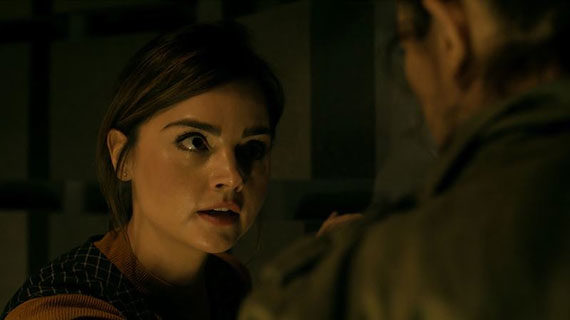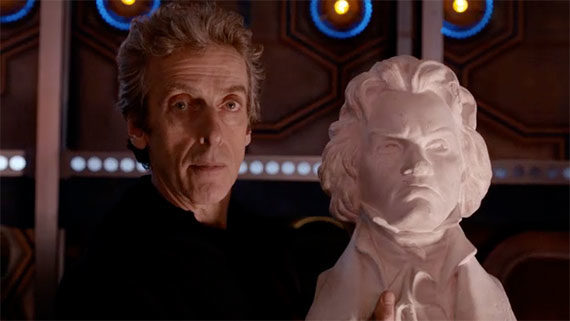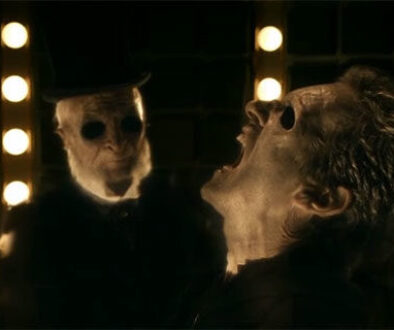Before the Flood Review
Clint Hassell gives his verdict on the fourth episode of Series 9.

Just as he did with the Doctor, in “Under the Lake,” scriptwriter Toby Whithouse spends much of “Before the Flood” developing Clara. Though it feels as if he is working from notes, provided by showrunner Steven Moffat, that delineate her arc for Series 9, Whithouse still demonstrates his signature understanding of the effect of TARDIS travel on companions. In fact, Whithouse manages to accomplish something that has thus far eluded Moffat: linking the moon-eyed Clara that traveled with the Eleventh Doctor, in Series 7, with her current, controlling personification.
In the first act of “Before the Flood,” Lunn asks Clara what she’d say to someone she encountered who was scared – – because he’d like to say that to her. One of Doctor Who’s signature themes has always been ordinary people displaying the character traits required of a “companion,” as the compassionate, empathic Lunn does here. Clara’s answer demonstrates that she has acquired a great deal of experience in crisis management and grief counseling. Particularly during Clara’s “impossible girl” storyline, Doctor Who has emphasized the sightseeing benefits of traveling through space and time – – meeting historical figures, visiting other planets – – but now, the narrative is pointedly showing the skill set that necessarily develops to survive in the Doctor’s perilous world.
Compare this scene to one in the second act, as observant Clara realizes that the ghosts are uninterested in killing Lunn, who has not seen the alien script. Lunn is convinced to venture outside the safety of the Faraday cage, until Cass asks if Clara was “always happy to put other’s lives at risk,” or if this is a practice learned from the Doctor. “He taught me to do what must be done,” responds Clara, before opening the door and ushering Lunn out. Here, Clara shows no regard for consoling the scared, only professional detachment.
Whithouse completes his comparison, as Clara chastises a Doctor again willing to give himself over to death:
“Not with me! Die with whoever comes after me; you do not leave me! . . . You owe me. You’ve made yourself essential to me. You’ve given me something else to . . . to be. And you can’t do that, and then die. It’s not fair.”
Most companions leave the TARDIS before they lose sight of who they once were, but Clara’s extended tenure provides the opportunity to explore how companionship changes a person, by mirroring the modern Clara against the nebulous girl wanting to see her “101 places,” in Series 7.
It is interesting that, while Clara promises Lunn’s safety – – certainly a reckless guarantee – – she has yet to behave herself in a careless manner, despite the Doctor’s concern that Clara’s desire for danger is beginning to cloud her judgment. Note that, when prompted, Clara states that she trusts the Doctor will save the day. There is a thin line between reasoned acceptance of risk and wild abandon, and, feeling that she has the Time Lord behind her, it still seems that Clara is walking on the right side.

With subtle references to previous companions, the Master, and the events of both “Deep Breath” and “Kill the Moon,” Whithouse again demonstrates a talent for organically interweaving Who’s rich canon into new adventures. Further, Whithouse manages to relate the Fisher King’s backstory – – knowing that he will be buried off-planet, and sensing his eminent defeat at the hands of the Arcateenians, the Fisher King faked his death; now on Earth, he is using ghostly electromagnetic projections of his murdered victims as a homing beacon for his invading armada; when they arrive, he will emerge from his suspension chamber, and overtake the planet – – via snippets of conversation between Prentis and the Doctor, without resorting to an expository infodump. Most impressively, Whithouse even manages to spin gold out of the sad fact that “Before the Flood” marks the third time in only four stories that the plot has centered around changing history to prevent the death of a loved one. “You can’t just go back and cut off tragedy at the root,” admonishes the Doctor, decrying the practice, “because you find yourself talking to someone you just saw dead on a slab. Because, then, you really do see ghosts.” With this meta comment, Whithouse displays an incredible depth of understanding, not just of the nature of time travel, but also of Doctor Who as a serialized narrative, and the limitations of oft-repeated storylines.

All this being said – – and Whithouse truly deserves praise for crafting such a dense, layered, two-part adventure that both builds on previous storylines, and further develops Series 9’s arc – – there are parts of “Before the Flood” that are not well-written. If “Under the Lake” was a master class in script writing, “Before the Flood” provides several “how not to” examples.
For instance, the episode begins with a fourth wall-breaking intro where the Doctor explains bootstrap paradoxes directly to the audience. While “Listen” utilized a similar narrative device as its teaser, presenting a non-standard introduction that highlighted the truly series-redefining aspects of Steven Moffat’s magnum opus, the opening proved detrimental to “Before the Flood.” While the teaser has several clever moments – – the scowl on the Doctor’s face matching that of the Beethoven bust, hinting to the audience that the two might actually be the same man; the rocking, updated theme music – – it spoils the surprise reveal of the episode’s ontological twist for the audience. Never start a joke with the punchline.
O’Donnell’s literally jumping up and down with glee after her first trip in the TARDIS is an episode highlight. With her UNIT past, and her encyclopedic knowledge of the Doctor’s history, it is clear she is modelled after fan-favorite Osgood. Heck, her line, “Never gonna happen. Seriously, have you to met me?” indicates that O’Donnell even has a little of Shona McCullough’s mouthy attitude. What fan doesn’t identify with O’Donnell’s excitement in meeting the Doctor? This becomes a problem though, as Whithouse mines the audience’s endearment only to infuse the character’s poorly-plotted demise with pathos. For the script to set up the character as a fan-favorite, and to then have her death lack thematic complexity is manipulative.

To make matters worse, the narrative suddenly states that Bennett and O’Donnell were in love. Realizing that, despite writing her with the flair of a fan-favorite character, O’Donnell’s death scene is a catch-all of tropes and carries no emotional weight, Whithouse tries to use the revelation to create a sense of heartbreak in the audience. This would be fine, had there been any indication of their mutual feelings, before this scene. Instead, the reveal is apropos of nothing, inserted only to up the emotional ante. That’s exploitive, and a cheap writing shortcut.
Finally, despite Whithouse’s amazing talent for diverse characterization, frank dialogue, and a tightly-plotted narrative, “Before the Flood” includes at least two extreme leaps in logic. The more problematic of the two involves the Doctor’s holographic “ghost” being able to affect physical objects as it opens the Faraday cage, releasing the three apparitions trapped inside during the previous episode. The Doctor’s explanation for his “ghost” is deliberately vague, but apparently presupposes either that his sonic glasses can project solid-light holograms through a deadlock seal, or that the sonic glasses link, via Wi-Fi, to the underwater base, which itself projects the hologram. The former borders on magic and is lazy; the latter undermines the feasible future-tech designs presented in “Under the Lake” and is, well, silly.

Aware of the script’s shortcomings, is it possible to further refine the adventure, without reconceiving story completely? Certainly! For starters, the romantic elements of “Before the Flood” should be introduced early in “Under the Lake.” The Doctor arrives to find that the close quarters of the underwater base have drawn the crew into couples, with Pritchard’s selfish character now partly explained by his role as a “fifth wheel,” of sorts. Uncomfortable with the couples’ flirting, the Doctor realizes that he and Clara also share incredibly close working quarters, allowing Whithouse to further examine the intimacy of the Doctor/companion relationship. “Before the Flood” then starts with a brief recap, but no actual teaser, the Doctor’s story about Beethoven moved to the episode’s final scene, where both Clara and the audience can be surprised by the ontological twist.
Perhaps the biggest change involves leaving the three ghosts from “Under the Lake” in the Faraday cage, eliminating the need for the Doctor’s “ghost” to affect physical objects. Instead, Clara, Cass, and Lunn are chased by O’Donnell’s spectre, which appears, after her death in the past. The stakes are increased now, as Clara and company can’t seek shelter in the Faraday cage, which already contains ghosts. As an added bonus, Cass and Lunn now have the chance to grieve for their friend, their sad feelings set in stark relief against their need to survive. Further, knowing that the Doctor couldn’t protect O’Donnell, Cass and Lunn begin to question how safe they are with Clara and her promise of safety.
Of course, “hindsight is 20/20” . . . or is it, when considering decisions that have already occurred in one’s relative future? “Before the Flood” contemplates the idea as the Doctor remarks, “This is the future, now. It’s already happened,” a brilliant line that blurs past, present, and future in a way only Doctor Who can. This line is evidence of the most compelling argument for Toby Whithouse as showrunner – – his deep understanding of Who’s unique format and the storytelling opportunities it offers – – and the best example of why “Under the Lake”/”Before the Flood” is a good, if not great, example of the show’s potential.









